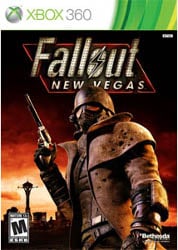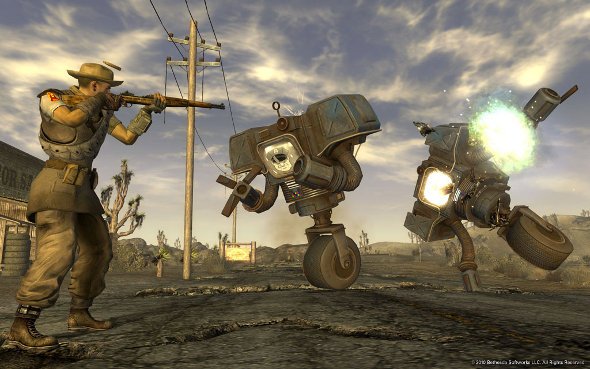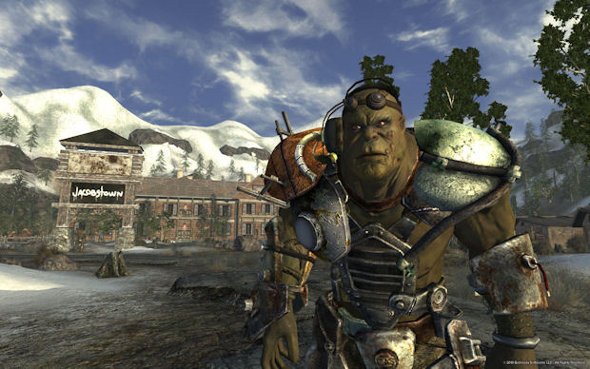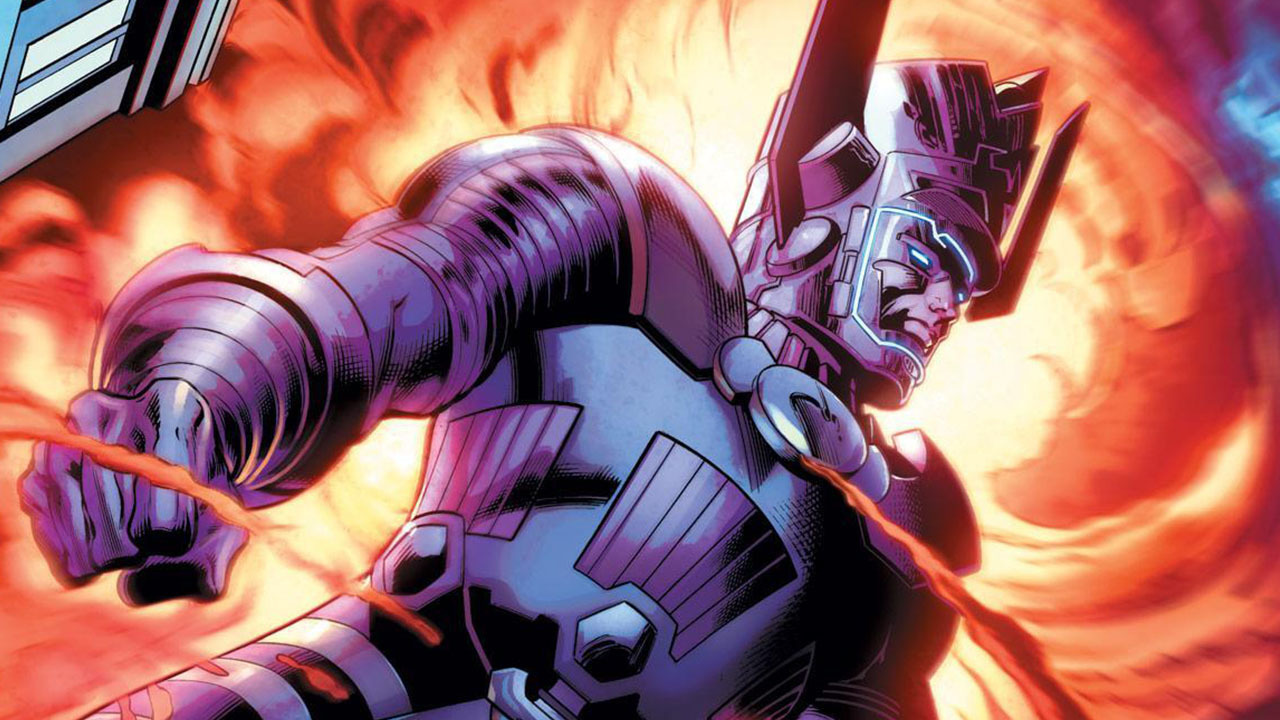Review: Fallout: New Vegas

Bethesda recently took over the reins of the popular Fallout series with Fallout 3. Now, two years later, they welcome gamers back with Fallout: New Vegas. This time they're merely the publisher, though. New Vegas was developed by Obsidian Entertainment, a company founded by veterans of Fallout and Fallout 2 creators Black Isle Studios. The change in developer isn’t as big of a change as you might expect, though. After spending nearly a week with it thus far, I can simply state that if you were a fan of Fallout 3, then Fallout: New Vegas will give you more of what you loved.
In New Vegas, you play as a courier who is ambushed while attempting to deliver a package and left for dead. The Courier, as he/she is referred to in the game, is rescued by the robot Victor and brought to Dr. Mitchell in the town of Goodsprings. After you awaken, the good doctor asks you a series of questions to determine your skills and attributes (much like the G.O.A.T. exam in FO 3). Your mission, should you choose to accept it, is to track down your attempted murderer, find out why they wanted you dead and maybe get some revenge while you’re at it (insert wicked Vincent Price laugh here).
The combat hasn’t changed with the exception of a new V.A.T.S. skill that allows players to perform a special V.A.T.S. attack with certain melee weapons. The best example is the golf club, which has a special attack referred to as “Fore!” The V.A.T.S. system is otherwise exactly where we left it in FO3, where a player can target an enemy’s specific body parts while spending a number of Action Points for each attack. While you can play the game just like any other FPS, most players will just use V.A.T.S. a majority of the time. And who wouldn’t want to? It’s much simpler to try to snipe a few enemies from 100 yards away with V.A.T.S. than it is to go in trigger-happy and hope you don’t end up nailed to a cross for the radscorpions and fire ants to have their way with you. The game also allows you to switch between first-person and third-person view, with a significant improvement from FO 3’s third-person perspective, but let’s be honest – you should probably just stick with the first-person view. Combat isn’t nearly as good in third-person as BioWare’s Mass Effect games. The Mass Effect games have been designed specifically for third-person gameplay. Since Fallout 3, the approach has been focused more on first-person. While playing with the camera angle in third-person, the game tends to sputter at times and the player’s character sometimes becomes a floating torso, which just looks awkward. Like most RPGs, the goal is to imagine yourself as that central character, so why wouldn’t you want to view the game world as if it was through your own eyes?
You’ll have plenty of new weapons to play with, including the Grenade Rifle and dynamite. There’s also a weapon modification system. Before you get too excited, please note that you are restricted to only applying three different types of mods to each weapon – silencers, additional magazine size, and greater weapon damage or rate of fire. The modifications are pretty basic and don’t add much new flavor to the weapons. They do allow for an additional layer of customization in a game that already offers it in droves, though.
Weapons and armor still degrade with use but the process of repairing them is less annoying this time around. Items can be repaired just as they could before, but this time around they can be fully repaired even without a 75+% Repair skill. Merchants who offer repairs can also fully repair a weapon, not based solely on theirs/your Repair skill. It’s all about the caps this time. Considering your Repair skill still affects how much your weapon is actually repaired each time you do it yourself, though, this is still a valuable skill.

Companions also make a return in New Vegas. There are eight possible companions to recruit and you can have two in your party at one time (one humanoid and one non-humanoid). Instead of directing them through dialogue in FO3, you can use the new companion wheel interface. This may seem cool and inventive at first glance, but really the only thing it offers the player is the opportunity to heal them with a Stimpak or to simply keep an eye on their health. Needless to say, the control you have over your companions feels exactly the same: you can set equipment and combat preferences (melee or ranged), their passiveness or aggressiveness, and their following distance (close or far).
One nice thing about your companions is that they have real personalities. In FO3, the closest we got to that was Fawkes, the human experiment-turned-super mutant. Fawkes was intriguing because he at least had somewhat of a back story with some rather interesting dialogue (“Wake up…time to die!”). The companions in New Vegas all have back-stories and can only be obtained through questing. You can’t just go up and talk to one and say, “Hey, come join the party brigade!” No, you have to earn their companionship. What’s even better about these companions is that they actually do something other than fight. Each comrade is specialized with certain skills, be it melee or energy weapons, stealth or even healing. Also, each companion has a special perk to help aid you in combat. With all of their different specializations and perks, certain situations may require different companions. For example, my first companion in the game was the eyebot ED-E, who grants the character a bonus to Perception. A higher perception allows enemies to show up on your radar from further distances, which makes sneaking into an enemy base much easier.
CINEMABLEND NEWSLETTER
Your Daily Blend of Entertainment News
Should your companions happen to fall in battle, have no fear. Once you have eliminated all hostile threats in the area they’ll wake up as if nothing ever happened. This, too, is incredibly useful because instead of having to worry about tending to them while in combat you can focus more on your enemies. It was really annoying having to babysit NPCs in FO3. Companions also “warp” to your location at times, cutting down on pathfinding mishaps from the previous game. You no longer have to worry about your comrade plummeting to his death when he tries to follow you down a hill.
Another key addition to the game is the return of the reputation system from FO and FO 2, which was notably left out of FO3. Reputation compliments the Karma system, which was untouched. Karma affects your overall “good or evil” personality. If you steal from or break into someone’s home, you’ll earn yourself negative Karma points. Do some good deeds and you’ll be rewarded with positive Karma. Karma is only relevant to the NPCs that you affect. Should someone catch you stealing from them, you can be certain they’ll try to gun you down. Reputation, on the other hand, affects how overall settlements and factions view you. With certain quests, a town’s citizens may ask you for assistance. Depending on whether you help them or an opposing faction will determine which group idolizes or vilifies you. One of your first quests in the game puts you in the middle of a conflict between the residents of Goodsprings and a group of escaped convicts known as the Powder Gangers. You can choose to side with the citizens of Goodsprings and defend the town, or wreak havoc on them with the Powder Gangers. Whichever you choose, the NPCs that are negatively affected by your decision will view you as a hostile from this point on. This may not seem too important at first, but as the game progresses, you will need to determine who you want assisting you in the final outcome of the campaign, and that all comes down to what actions you choose when dealing with each faction.

The factions that exist within New Vegas include the Brotherhood of Steel, the New California Republic (NCR), the Nightkin, Followers of the Apocalypse, and Caesar’s Legion. This may seem like a lot of different groups to take in, but you’ll be doing most of your business with are the NCR, Brotherhood of Steel, and Caesar’s Legion. Which group you help depends on how you like to play the game. Do you want to be a bad-ass, an evil slave trader or a goody two shoe? If you’re like me, then you’re a bit of a wimp and will stick with the NCR, the “good” guys (though it’s not so black and white). The NCR essentially stands for democracy, while the Brotherhood is attempting to recover pre-war technology (specifically, really sweet armor and weapons). If those options don’t appeal to you, you can join up with Caesar’s Legion and dabble in the slave trade. Wonder how much they’d pay you for that villager?
Bethesda and Obsidian took note of many gamers’ complaints about FO3’s difficulty, and so they have now added a brand-new gaming mode: Hardcore Mode. And when they say Hardcore, they’re not kidding around. The biggest difference here is that you MUST eat, drink and sleep in order to keep your character healthy and up-to-par. You also cannot fast travel if your character would need to eat or drink within the time it would take to fast travel there. Limbs also cannot be healed by sleeping or applying a Stimpak to them and can only be fixed by either using a Doctor’s Bag or by seeing a doctor yourself. If you’re like me, then you probably enjoy carrying a large assortment of weapons and armor on you at all times, because certain situations call for a particular gear set. This, however, will simply not work in Hardcore. Ammo also adds weight to your backpack so a lot more strategy is needed in order to survive. Also, if your companions fall in battle don’t expect them to pull a “Great J.C.” and rise on the third day. Once they’re dead, consider them Bighorn grub. With only a few hours of gaming with the Hardcore Mode, I can tell you it’s not for the meek. While it’s frustrating, it does offer up a great opportunity to really challenge yourself after your initial play-through in Normal Mode to see if you can survive the Wasteland with limited resources.
New Vegas is not without its flaws, though. There were many bugs with the game upon its release, some of which resulted in crashes. A patch has since been issued for the PC and the Xbox 360 to fix a few of these issues. The PS3 update is still in the works. You can never be too careful, so save often. During my play-through, I did not experience a single crash bug, but glitches were plentiful – the familiar radscorpion or feral dog sinking into the ground, unable to be attacked, and the ever-so-humorous floating raider.
One last bit to note, though, is the deceptiveness of the game’s title. Fallout: New Vegas does not predominantly take place within the city of New Vegas. New Vegas is only featured much later on in the campaign and only for a short period of time compared to the rest of the expansive game. While you may not spend much time within the casino and prostitute-ridden New Vegas, there are other sites to point out which can help distract you from this. The Helios 1 solar energy plant contains a massive super laser as you all saw from the trailers, and the Hoover Dam is a site of perpetual conflict between Caesar’s Legion and the NCR. There are even a few Vaults within the game world, for all of you nostalgic vault dwellers out there. Rather than the decrepit wastes of D.C.’s Capital District from FO 3, though, New Vegas primarily leaves you wandering around the Mojave Wasteland, mostly consisting of desert and mountainous landscapes. A bit bland I think, unless you’re a cowboy, a dude ranch owner or a newly-resurrected Roy Rogers. The landscape of FO 3 seemed more haunting with a greenish-gray tone, while New Vegas is smothered in sepia, with Wayne Newton’s pleasant voice on the radio to boot.
Fallout: New Vegas does boast, however, roughly 100 hours of game play, with the promise of DLC expansions to keep up the questing and looting. This game isn’t simply Fallout 3.5 - it does stand out on its own. The story is new, the graphics are beautifully rendered and the few additional features they did add all seem to make the game better than the last installment. Yes, there are some glitches in the game, some of which have already been repaired, but if you love the series, you can look past them…for now.
Players: 1
Platform(s): Xbox 360 (reviewed), PS3, PC
Developer: Obsidian Entertainment
Publisher: Bethesda Softworks
ESRB: Mature
Rating:

This Viral TikTok Of An Epic Universe Parkgoer Admitting To Going To Previews So He Could Steal (And Getting Arrested) Has Theme Park Fans Mad
I'm Still Thinking About Warfare's Most Intense Scenes, But Joseph Quinn Says Filming It Bled Together
The Fantastic Four: First Steps Director Thankfully Didn't Rely Solely On Motion-Capture To Bring Galactus To Life, And I Couldn’t Be Happier With This Approach









